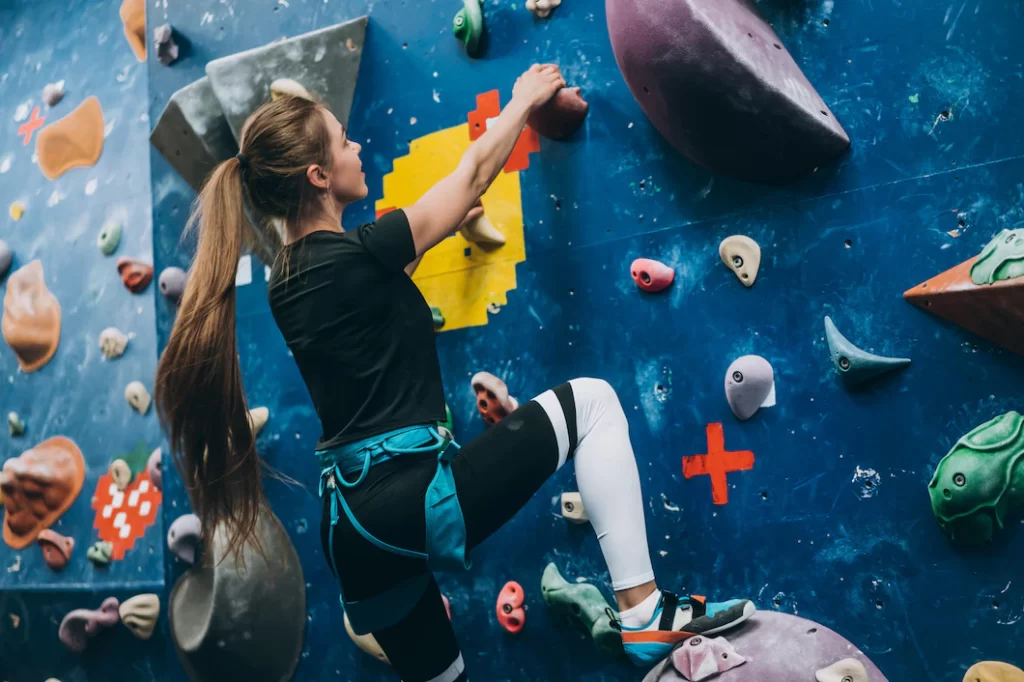Are you new to bouldering? It’s an exciting, challenging sport that offers great rewards for those willing to put in the time and effort. Bouldering stands apart from other sports because it requires a person to climb short walls with no ropes or harnesses, making for an ultimate physical challenge. If you’re looking for a strengthening workout with some serious fun, then bouldering might just be the activity for you. In this beginner guide, we’ll cover everything from proper training techniques to what gear you need so that you can make sure your next climbing session is the best one yet.

What gear is necessary for bouldering training?
Before you embark on your exciting climb, be sure to equip yourself with the essentials. A good pair of climbing shoes is necessary — they’ll provide extra grip and support as you ascend rocky walls. Don’t forget a chalk bag either; powdered chalk will reduce slipperiness and give an added boost to those tricky sections!
Falling can be dangerous and a crash pad is often a lifeline for climbers. To stay safe, it’s important to have the right protective gear including helmets, harnesses, and belay devices — especially when bouldering outside!
How to train for bouldering: techniques to use
Bouldering is an incredibly rewarding activity that can not only boost your physical power but also cultivate your mental fortitude. To achieve bouldering success, it’s important to have a well-rounded training program with the right components. Ready to climb like a pro? Check out these top-notch techniques that will help you train for bouldering success:
- Endurance training. Bouldering is a crucial way to build the physical strength, endurance, and knowledge required for extended routes. Enhancing your stamina is achievable by focusing on aerobic exercises like running, cycling, and swimming.
- Strength training. It contributes to your overall power and stability. Exercises such as squats, push-ups, pull-ups, and weighted carries are great for building strength.
- Grip training. Having a powerful grip is key in bouldering, as it’ll enable you to maintain your holds for longer and maximize your climbing potential with greater efficacy. Exercises such as dead hangs, fingertip pull-ups, and pinch grip exercises are great for improving your grip strength.
- Flexibility and mobility. They’re important in bouldering, as they help you stay safe while climbing and reduce your risk of injury. Practices like yoga, stretching, and foam rolling can help improve your flexibility and mobility.
- Nutrition. Proper nutrition is key for bouldering, as it helps fuel your body and mind for the challenging climbs that lie ahead. Eating a balanced diet with plenty of fruits, vegetables, and lean proteins will help keep you energized and performing at your best.
By incorporating these techniques into your training program, you can get better at bouldering and reach new heights.
How to get started in the right way?
If bouldering is new to you, having a game plan can make all the difference. Kickstart your journey by learning standard grips and postures — useful resources include books, videos, or local climbing classes that will provide an excellent foundation for understanding must-know techniques.
To improve your strength and endurance for bouldering, incorporate weight-training exercises into your routine. They’ll help you build the physical power needed to climb with confidence.
Additionally, be sure to stretch before your climbing session to get your muscles and joints ready. To prevent any injuries, it’s always wise to begin your workout with a proper warm-up on the wall.
Finally, be sure to get the right gear. Climbing shoes, chalk, a brush, and even a crash pad are all necessary pieces of equipment. If you’re bouldering indoors, your local gym should have these items available for rent or purchase. Once you’re all set, it’s time to get climbing!
With a little preparation and the right gear, you can enjoy the incredible challenge that bouldering offers. Don’t forget to keep safety a top priority, follow the tips above and have fun. Good luck!
We hope that this post has helped you to learn more about bouldering training and get started on your climbing journey. There’s no better way to challenge yourself than by taking on a physical activity like bouldering. Have fun, be safe, and get climbing!
Do you have any tips or advice that you’d like to share with our readers? Don’t hesitate to reach us. We’d love to hear from you!